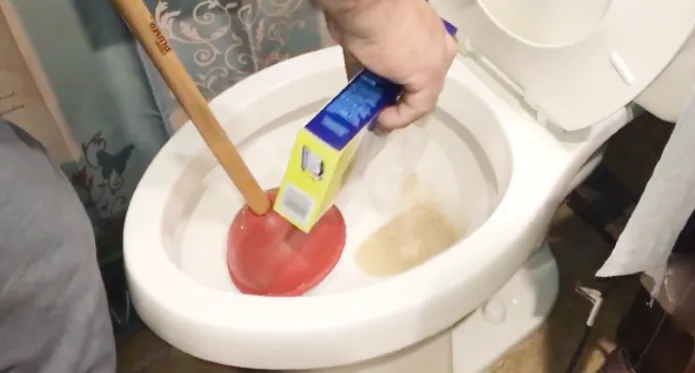Last Updated on October 17, 2023
Ready to make your commode a luxurious throne fit for royalty without the risk of a clog? You may have heard about using drain or septic cleaners, but can these products really be used in regular toilets?
Avoid using septic cleaners to clean your toilet, as they can seriously damage the pipes and release toxic fumes. Not only that, but it could also have a negative effect on the environment.
Instead, take these natural cleaning alternatives for a spin: baking soda plus vinegar, plungers, boiling water, and even dish soap is an option for regular toilets connected to a septic system.
We’ll show you how to make any regular commode connected to a septic tank sparkle in no time with easy DIY instructions.
Why Can’t You Use a Drain Cleaner in a Toilet?
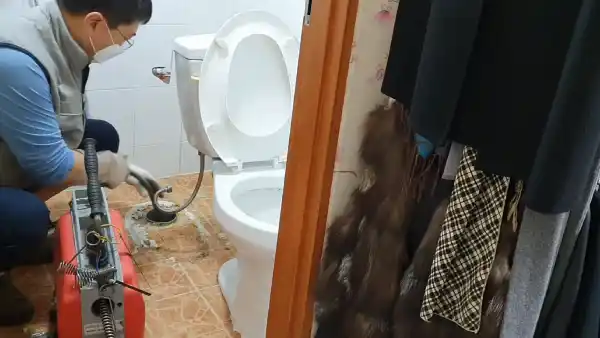
Using drain cleaner in a toilet is something that many people may not be aware of and can result in serious damage or harm to the toilet.
We will look at three reasons why drain cleaner should not be used in a toilet: damage to pipes and toilet parts, inhalation hazards, and environmental impacts of products.
1. Damage Pipes and Toilet Parts:
Drain cleaners can cause pipes and other components of the toilet. The chemicals found in drain cleaners are highly corrosive, meaning they can quickly corrode metals and other materials that make up the plumbing system.
If these chemicals were poured directly into a toilet, they would corrode parts like the fill valve, flush valve, float cup, wax ring seal, etc., which could lead to costly repairs or even the replacement of the entire unit.
Additionally, if left unchecked for too long, corrosion from these chemicals could spread throughout the plumbing system leading to expensive pipe repair or replacement as well.
2. Potential Inhalation Hazards from Toxic Fumes:
It’s not recommended to use drain cleaner in a toilet due to the toxic fumes released by these products.
Chemical-based drain cleaners are not an ideal solution for toilets. When mixed, their corrosive ingredients, such as sulfuric acid and sodium hydroxide, create noxious vapors. Inhaling the fumes for long periods can become dangerous, provoking respiratory illness that is difficult to shake without proper ventilation.
Moreover, experts caution against using chemical-based products on toilets as they can emit noxious gasses when exposed to water which can be hazardous when inhaled directly or indirectly through skin contact with contaminated water droplets.
3. Environmental Impact of Products:
If tackling a toilet clog, it’s important to think beyond the immediate problem. Many chemical-based drain cleaners contain pollutants that can seep into our environment if you use them.
Not only can pollutants be dangerous to our health, but they also have the power to disrupt delicate water ecosystems. Runoff and high concentrations of chemicals like ammonia or chlorine reduce oxygen levels in these environments, leading to an ecological imbalance that could spell disaster for aquatic life.
As such, it’s essential to consider both short term and long-term environmental impacts before choosing a cleaning product for your bathroom fixtures.
Difference Between Septic Cleaner and Toilet Cleaner
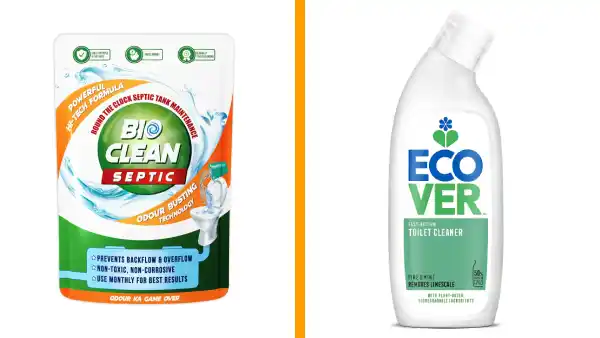
Septic cleaners and regular toilet cleaners are two different types of cleaning products that have their own unique purposes. Septic cleaners are specifically designed to keep a septic system healthy, while regular toilet cleaners are meant for cleaning and sanitizing the toilet bowl itself.
While there are some similarities between the two products, there are also some key differences that set them apart from one another.
Ingredients:
Septic tank treatments usually contain a mix of bacteria cultures, enzymes, surfactants, and other specialized additives that help break down organic matter and grease buildup inside the septic tank.
Regular toilet cleaners typically contain a combination of acids and cleansers like sodium hypochlorite or chlorine bleach, as well as surfactants and fragrances that help remove stains from bathroom surfaces.
The pH levels of each product also differ significantly because they serve different purposes. Regular toilet cleaner is typically formulated with a higher pH level (7 – 8) which helps to kill germs while leaving surfaces clean and sanitized.
On the other hand, septic cleaner is formulated with lower pH levels (5 – 6) which helps preserve the plants and microorganisms that naturally exist in a septic system by creating less hostile conditions for them to live in.
Higher pH levels can damage these organisms because they can upset the delicate balance within a septic system leading to clogging or malfunctioning of pipes over time.
Purpose:
Septic cleaners are used to maintain a healthy septic system by removing the buildup of organic matter and grease. Regular toilet cleaners are used for cleaning and sanitizing toilets by killing germs and removing stains. Most regular toilet cleaners are not suitable for septic systems.
Septic cleaners often come in liquid form, whereas regular toilet cleaner is available as either liquid or powder, depending on your preference or need. Regular toilet cleaner tends to be used on a much more frequent basis than septic cleaner since it serves as more of a preventative measure than anything else.
Pricing:
When it comes to pricing, there is also quite a difference between the two products due to their different formulations. Since septic cleaners usually contain specialized ingredients that aren’t found in regular toilet cleansers, they tend to be priced higher than their counterparts overall.
On average, you can expect to pay anywhere from 10-20% more for a quality septic tank treatment compared with its counterpart.
How to Clean a Toilet Connected to a Septic Tank?
Cleaning a toilet when on a septic system is a process that requires more attention than cleaning a toilet connected to the main sewer. Here are 4 effective septic safe toilet cleaners for cleaning such toilets.
1. Use Baking Soda & White Vinegar:

The combination of baking soda and white vinegar provides an effective septic safe toilet cleaner to clean and maintain your septic system. This mixture of natural cleaners helps break down the solid waste and clear out slow toilets. It can also help stop odors from forming due to bacteria buildup.
How to use:
Step 1: Begin by filling a spray bottle with white vinegar and spraying it inside your toilet bowl.
Step 2: Then sprinkle baking soda on top of it, as this will help break down solids in the tank.
Step 3: Take a toilet brush or a damp sponge and scrub the bowl thoroughly.
Step 4: Once done, flush the toilet, and you should have cleared any blockages or buildup inside the tank.
2. Plunger Method:
The plunger method is one of the most common ways of unclogging toilets, especially those connected to septic tanks. It helps clear any blockages in pipes without using any chemicals, making it safe for both you and your septic system.
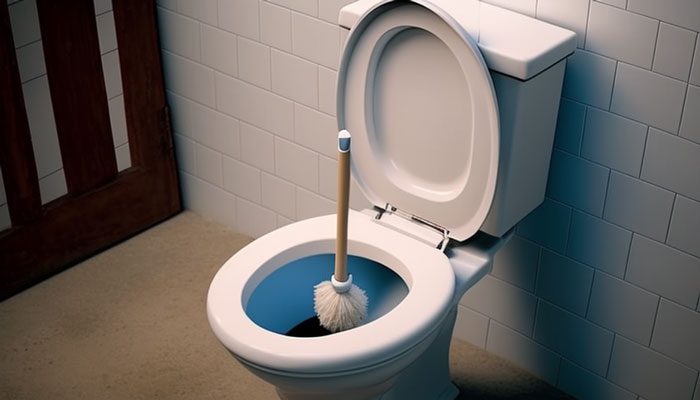
How To Use:
Step 1: Make sure there’s enough water in the bowl so that it covers at least half of the plunger head when placed on top.
Step 2: Place the plunger over the drain hole at the bottom of your toilet bowl, making sure it forms an airtight seal around it.
Step 3: Now begin plunging up and down firmly but not too vigorously as to avoid damaging any parts of your plumbing system.
Step 4: After several attempts, you should see whatever was blocking your pipes come loose and flow out with each flush after that.
3. Boiling Water Method:
One surefire way of eliminating both dirt and germs is by using boiling water. Not only is this method more hygienic, but it is also an effective way of dealing with stubborn stains and deposits.
How to Use:
Step 1: Begin by flushing the toilet, then add around two gallons of boiling hot water into the bowl.
Step 2: Allow the water to sit for several minutes (around 15) before scrubbing it with a toilet brush. Be sure to pay attention to hard-to-reach areas such as between the seat and bowl, under the rim, and along the crevices where germs tend to hide.
Step 3: Once you’ve thoroughly cleaned every inch inside of your toilet, flush out the remaining dirt and debris left behind in one single flush.
4. Dish Soap Method:
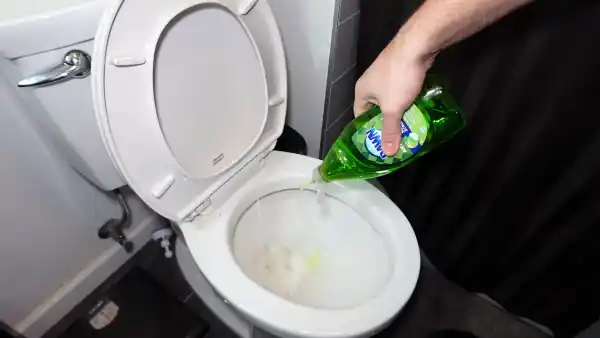
Another option when cleaning toilets connected with septic tanks is to use dish soap and warm water solution instead of boiling yourself out over whether you should use hot or cold liquid for this cleaning job.
Dish soap works best on grease and oil-based materials while being gentle enough not to damage most surfaces, including porcelain fixtures like those found in modern toilets, so it’s perfect for this type of job.
How To Use:
Step 1: Start by filling up your sink with warm soapy water mixed with about 1/4 cup of liquid dish soap (or enough for plenty of suds).
Step 2: Swish everything around so that all components are evenly distributed inside the bowl before allowing them time (around 15 minutes) to sit undisturbed.
Step 3: Grab your trusty scrub brush and start working from the top down, beginning along the lip area between the seat and lid, then proceeding downwards towards the outer edges until the bottom portion has been completely gone over at least twice more.
Step 4: Scrub away any grime from around the rim and inside of your toilet bowl using an old toothbrush dipped into this soapy solution.
Step 5: Wipe down all surfaces in your bathroom with an all-purpose cleaner designed specifically for bathrooms. This helps reduce odor while also providing extra protection against future build-up.
Step 6: Flush away all the dirt by running cold tap water from the sink (or using a bucket if one isn’t available).
Note: Make sure that no part remains untouched during this process either, even hidden nooks like those underneath the rim will need some love too. If grime persists despite repeated attempts, try increasing the amount used or switch out commercial-grade detergent instead.
What is 1 Thing That Should Not Be Flushed Down The Toilet?
Cotton balls, cotton pads, large clumps of hair, and Q-Tips are all items that should never be flushed down the toilet as they will not break down in the water.
Cotton is a natural fiber that does not dissolve and can cause plumbing problems when it enters the sewage system. These items could become lodged in pipes or other toilet areas, leading to clogs and even more serious plumbing issues.
It is a good idea to avoid flushing any non-biodegradable materials, such as plastic items like Q-Tips, since these materials can wreak havoc on local ecosystems and waterways if they end up there.
What Dissolves Toilet Paper Fast In A Sewer Line?
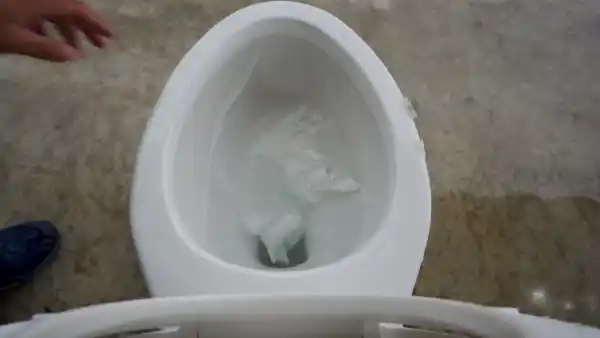
A combination of vinegar and baking soda can be used to help dissolve toilet paper quickly in a sewer line.
Vinegar is an acidic substance that can help break down certain fibers, including those found in toilet paper, while baking soda is alkaline so it helps to neutralize any acidity from the vinegar. Hot water helps to speed up this process by aiding dissolution even further.
What Happens If You Use Regular Toilet Paper In A Septic Tank?
Regular toilet paper is a safe and effective way to handle waste in septic tanks. The system’s bacteria break the septic safe toilet paper down quickly, allowing for the smooth digestion of your sanitation needs over time.
Keep Your Toilet Sparkling Clean Without Damaging the Pipes
Cleaning your toilet is an essential part of home maintenance, but you must choose the right cleaning product for the job. Septic cleaners are specifically designed for a septic tank, whereas regular toilet cleaners are made for those connected to a municipal sewer system.
If you decide to use septic cleaner in a regular toilet, remember that using a septic cleaner in a regular toilet can cause damage to the pipes and other components due to the toxic fumes released from the cleaning products.
For regular toilets, baking soda, white vinegar, and boiling water are great alternatives for effective cleaning without risking damage or hazardous fumes. With proper maintenance, you can keep your home’s toilets sparkling clean with minimal effort.

